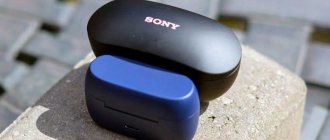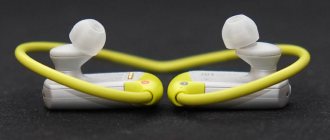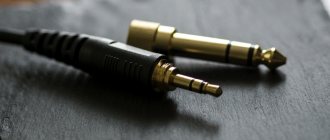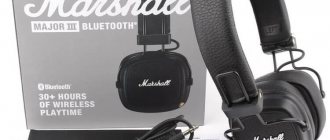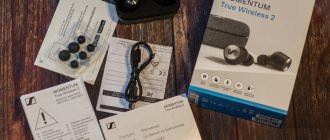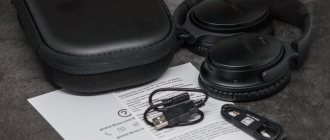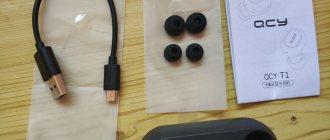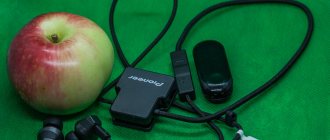Review of Sony XBA-H1 hybrid headphones
Having been listening to music on my smartphone for a long time (now Xperia Z3, formerly Z2 and Z) and only on it, I began to often think, why not try to switch to some higher-quality in-ear headphones in terms of performance and sound beyond $40. Before that, I mainly used the MDR-NC31EM (it came with it and was generally satisfied with it), and even earlier the MDR-EX310.
Headset NC31EM
MDR-EX310
I wanted something related to fittings, because... I just haven’t even considered more expensive ears with regular speakers (we don’t take extreme options for $300 into account). Being a Sony supporter, I began to take a closer look at the XBA series - one of the best line of in-ear headphones in the world. However, after reading the reviews, I quickly realized that for a phone such solutions would be redundant and unacceptable for many factors, not to mention their cost (and I didn’t want a single-driver model for $50).
Therefore, I paid attention to the Sony XBA-H series of hybrid headphones, which combine the advantages of dynamic and reinforcement “ears”. I particularly liked the younger model XBA-H1. Primarily because of its balance and reasonable cost (approx. 110 $ or 3990 rubles in the official Sony store). It contains one armature driver and a 9 mm speaker.
In addition, I was afraid that the older model (XBA-H3) would be too cool for any smartphone, which, however, was partially confirmed even when using the XBA-H1.
[divider]
Sony XBA-A1AP (black)
+: SOUND. Natural, clean, not dull, not intrusive, emphatically bright in the upper mids, moderately sonorous, musical and perfectly detailed. Nothing unnecessary is stuck out, everything sounds natural, without excessive distortion. They play any musical genre well. It’s just that the bass, in my opinion, lacks a little elasticity of impact and rolling effect. But overall, the lows are lush, without being boringly velvety and without a droning boom. That is, the sound quality more than justifies the price. And yet we should not forget that these are not full-size headphones. You can’t feel the full depth of the music and the breadth of the stage in plugs. Alas. But in any case, this is a solid, well-made baby with a decent sound!
-: ERGONOMICS is imperfect, simple. The fit is controversial and not very comfortable. Although these design flaws can be easily tolerated. Take the time to try on all the ear pads from the kit. (The medium ones with foam filler suited me). Oddly enough, I did not notice any difference in sound in different ear pads. Therefore, I chose it according to convenience. When purchasing, you will have to choose between inconvenience of use and amazing sound. I made my choice and do not regret the purchase. Other features of the model are indicated in the technical specifications and reviews. I won't repeat myself.
Review: I was wondering why the reviews for these headphones are mutually exclusive, polar different. From enthusiastic to angry. Some people don't have enough bass, some people don't have enough volume, and for others it's too much. Wrong ear pads? Poor quality mp3 audio recording below 320 kbps? Habit of excessively bassy “hooks”? Incorrect comparison with full-size ones? Yes, that’s true, but the main reason is the source. Although the Sony XBA-A1AP is positioned specifically as a model for a smartphone, it reveals itself differently on the player. Moreover, it sounds different on different players. I realized that the armature manifests itself excessively “brightly” on mediocre equipment and hurts the ears. In addition, there is a failure in the middle, so the vocals will be bad. I tested on 2 phones, on 2 players (with and without amplification), on a laptop + connected to an external sound system. And what’s surprising is that the sound is different everywhere! PS The manufacturer stated a resistance of 24 Ohms. But in fact, the impedance of this model is approximately 30 Ohms, this must be taken into account when choosing a source, and, accordingly, estimating the battery consumption time.
Packaging, delivery set
The XBA-H1 comes in a packaging that matches the level of the device, beautifully designed, consisting of a colored cover (with images of musicians from the band Hurts) and a dark-colored box with a soft, somewhat reminiscent soft-touch surface.
They did it well and at the same time not too arrogant. When you pick up the box, you immediately understand that this is a serious product, but they don’t try to “shout” about it to you, like in the notorious Beats dr. Dre or Monster, but they just report.
Opening the box we see the headphones themselves, and lifting the lid we find a case, a clip-latch for attaching to clothing, a bar for adjusting the length of the cord, a set of silicone rubber earbuds (sizes SS x2, S x2, M x2, L x2) and another set of earbuds made of foamed silicone (sizes SS x2, S x2, M x2, L x2).
[divider]Appearance
I have always liked the design of Sony headphones, and especially the XBA series, it is clearly not boring and at the same time not too catchy and defiant. The headphones look cool in their own way, but without any kinks with an eye on teenagers, which means they should look equally good in the ears of people with different looks and styles. Again, SonyStyle, for which the Japanese company is so loved, is fully present in this product.
It is noticeable that when developing the design they did not try to copy anyone, but looked for solutions and thought for themselves, although Sony could never be blamed for this issue.
In the design, a lot of attention is paid to small, initially unnoticeable details. For example, the meanings of the right and left headphones are correctly duplicated: with the letters R in red and L in gray on the inside and stripes of these colors built right into the XBA-H1 body. A very interesting idea from a design point of view, but at the same time extremely convenient in everyday use.
If you have never encountered this kind of “plugs” before, it may seem that the H1 case is too large. However, they weigh a little, there is not much difference with cheap headsets, and the headphones have a completely different level of strength: the internal frame is made of magnesium, and the top is ABS plastic. The cable connection points are covered quite seriously, unlike more budget analogues.
The cable is implemented in an interesting way; it is flat and textured with longitudinal lines, the outer side is painted black and the inner side is painted red. Due to this, sometimes it seems that the wire consists of two layers glued together. This is not true, the cable is, of course, the same, but this effect helps make the design of the headphones more solid and complete.
[divider]
Headphones Sony XBA-1, XBA-3 and XBA-sport (testing, feedback, review)
I recently told you that I have never had good headphones. I didn't think much of it until Philips gave me full Philips O'Neill ears. That's when I realized that portable headphones can be of very good quality. And to my ears it’s generally very difficult to please. Since testing posts are causing an extraordinary surge in traffic, I will continue. Next up is a new product from Sony.
During my month-long testing, I used Sony XBA line . More precisely XBA-1, XBA-3 and XBA-sport . If anyone follows the news of gadgets, then they should understand my delight at the opportunity to “listen” with my own ears. If not, then I'll tell you why it's so cool. Sony has always managed to create something unusual. In the modern realities of Apple’s dominance, they no longer reach the revolution (how I loved my cassette Walkman, oh), but in terms of product quality they remain more than competitive. With the advent of XBA, we can again talk about a revolution in the minds of consumers. The task is not easy - Sony has developed and released in-ear headphones (earphones), which are comparable in quality to “big” ears. In press releases. Who else but them? It was Sony that released the first music player back in 1979.
The numbers in the model range (XBA-1, XBA-2, XBA-3, XBA-4) indicate the number of drivers . Of course, XBA-4 is the coolest - they have broadband, low-frequency, high-frequency and ultra-low frequency). The pair of headphones that I had for testing is the XBA-3 - unlike the XBA-4, it only lacks an ultra-low-frequency driver. However, I am sure that this will not be noticeable to the untrained ear.
But the overall sound quality is much better than all my previous headphones. An important point is the price . XBA-3 cost almost 10,000 rubles. And it makes sense to buy from only if your sound-reproducing equipment has the appropriate quality level. And for portable systems (you wouldn't use in-ear headphones at home, right) this is a pretty big problem.
As a more affordable alternative, you can use the XBA-1 for 2000 rubles, or the sports version XBA-S65 at a similar price. In any case, any model in this series is an order of magnitude superior to the vast majority of headphones that I was able to test, and the shitty beepers from the iPod are left far behind. It will be difficult now without them, but there are still so many discoveries ahead)
Audio
Specifications:
- Type - Hybrid (1 speaker + 1 armature transducer)
- Frequency range - from 5 Hz to 25 kHz
- Sensitivity - 105 dB/mW
- Resistance - 40 Ohm
In this review I will not talk about sound from the point of view of an audiophile, because I am not one. I also consider it unnecessary to focus attention on individual compositions, talking about how the guitar or vocals sound at certain moments. I’d rather tell you what changed in the sound after switching from NC31EM to XBA-H1, what changed the perception of music.
I must say that MP3 in the memory of my Xperia Z3 is an infrequent occurrence; the music library mainly consists of .flac files with a bitrate of at least 600 kbps. Occasionally, I even record uncompressed albums with parameters similar to Hi-Res (96 Khz and 2500 kbps), mainly due to the difficulty of finding the necessary instrumental and classical music in the usual stream.
On the NC31 headset, if I noticed the difference between lossy 320 kbps and lossless, it was mainly at low frequencies. This manifested itself in more developed bass: in mp3, the lows are basically an all-filling hum, which does not leave enough space for the rest of the range.
After switching to the XBA-H1, the difference became noticeable not only in the bass. The MP3 format began to look not as acceptable as it seemed before, and the normal (compiled from CD licenses, etc.) FLAC, on the contrary, began to play in a new way:
Detail - if previously the music was more like a melody with difficult to distinguish components, then on the XBA-H1, if desired, you can easily hear individual instruments, but this does not ruin the overall composition, the harmony is fully present.
Balance - the noticeable bias towards low or high frequencies has disappeared. H1 try to maintain a reasonable ratio throughout the entire frequency range.
Clarity - after the complete headset you notice it immediately. It’s difficult to force “ears” into a situation where they start stumbling and mixing everything up. Almost any H1 track of normal quality is tried to be worked out as correctly as possible.
Unfortunately, due to serious resistance (considerable 40 ohms), the Xperia Z3 is not able to fully pump these hybrids due to insufficient voltage supply to the built-in amplifier. Apart from purchasing an additional portable amplifier or a separate Hi-End player, there is no other way to solve this issue. However, for me personally, the volume and level of pumping that the phone provides is enough. Even so, the quality of playback in many aspects has moved to a new level. [divider]
Review of Sony MDR-1A headphones
Over the past few years, a new category has emerged in the headphone market, which can roughly be called “portable full-size headphones with high sensitivity and a replaceable cable.” This includes models such as the Philips Fidelio L1 or Sony MDR-1R. The success of such headphones is clear: they usually sound good, provide good comfort and are also universal (that is, they can be used with both a smartphone and other equipment). Today we will look at the Sony MDR-1A headphones, which replaced the MDR-1R model.
About the scope of delivery
The MDR-1A package is standard for Sony headphones and includes a fabric carrying case, two replacement cables (with and without a remote control for the microphone) and an adapter for a 6.3 mm large jack.
About appearance
The Sony MDR-1A continues Sony's long-standing headphone design tradition. Outwardly, they are almost no different from the MDR-1R model, which, in turn, clearly shares common “family traits” with the legendary MDR-7506 model. This design is so successful that it was “borrowed” by Audio-Technica for the ATH-MSR7 model.
Alas, the MDR-1A's materials are worse than its appearance: almost all supporting structural elements are made of plastic, including the hinges and forks on which the cups are attached. The cups themselves, however, are metal. The ear pads and headboard trim are made of leatherette, so your ears will sweat in hot weather.
About convenience
Sony MDR-1A is one of the most comfortable closed-back headphones available on the market. They fit very well on the head, do not slip and do not put pressure on the ears, so you can listen to music in them for literally hours. The sound insulation of the MDR-1A is above average, but, of course, inferior to the “plugs” (simply due to the design).
I really like the ability to change cables, as it allows you to use the headphones with your smartphone, computer or hi-fi equipment.
About sound
We listened to the Sony MDR-1A with a variety of sources - smartphones (iPhone 6, Samsung Galaxy S6 Edge, Motorola Moto X), a MacBook Pro laptop, external FiiO E17k and SMSL M2 DACs, a Creative SB X-Fi Surround 5.1 Pro sound card and a budget Behringer U-Phoria UM2 audio interface.
The Sony MDR-1A sound noticeably better than the previous model (MDR-1R), with less mud in the midrange and well-developed bass. In general, the sound can be described as very good and neutral in terms of genre preferences.
Even though the MDR-1A has an impedance of 24 ohms, it doesn't sound very good with phones and other low-power sources. They need a high-quality and powerful source in order to fully open up.
Bottom line
To summarize, we can say that the Sony MDR-1A are pretty good headphones that look good, fit comfortably on the head and sound very good. Moreover, they come complete with two replaceable cables, which allows you to use them with both a smartphone and other sources.
Unfortunately for Sony, there are Audio-Technica ATH-MSR7 headphones on the market that cost the same, look very similar, are better built (using more metal) and sound noticeably better. The only advantage of the MDR-1A over the ATH-MSR7 is a more comfortable fit (the ATH-MSR7 puts more pressure on the head and listening to music for a long time in them may not be very comfortable). Personally, I recommend Audio-Technica headphones for purchase.
2 reasons to buy Sony MDR-1A:
- very convenient design;
- good sound.
2 reasons not to buy Sony MDR-1A:
- too much plastic;
- There are better options available in the same price category.
| Specifications Sony MDR-1A | |
| Drivers | dynamic, 40 mm, with neodymium magnets |
| Frequency range | 3-100000 Hz |
| Impedance | 24 ohm |
| Sensitivity , dB/1 V | 105 |
| Maximum power | 1500 mW |
| Cable | Replaceable, complete with cables with and without remote control (1.2 m) |
Ergonomics, ease of use
At first, given the dimensions of the XBA-H1, it was quite unusual to use. But having replaced the ear pads, which are standard in size and too big for me, for smaller ones, and after walking for a few days, I have no desire to return to the previous ones, which now seem “plastic-like” weightless. I note that I ended up using regular rubber earbuds; I liked the sound in them more than in the silicone ones. Perhaps it was my imagination, but there was a feeling of some muffledness with the silicone foam ear pads.
I was pleased with the flat, tangle-free cable, which, even if it gets tied into knots, untangles quite easily, much easier and faster than the usual wires in budget headsets. In the cold, everything is fine: the insulating coating of the cable does not harden and remains almost as elastic.
[divider]
conclusions
Everything here is clear and categorical, the XBA-H1 is one of the best options in its class, for its, let’s be honest, moderate price (let me remind you, the official price in Russia is 3990 rubles). I couldn’t find any worthy competitors for the money, especially considering the quality of workmanship and the scope of delivery.
If you are choosing new headphones and want to try hybrid or armature “ears”, feel free to take the XBA-H1, you are guaranteed to experience better quality sound.
pros
- Design
- Contents of delivery
- Wonderful cable
- Sound worth the price
Minuses
- No
sonyXBA-H1
